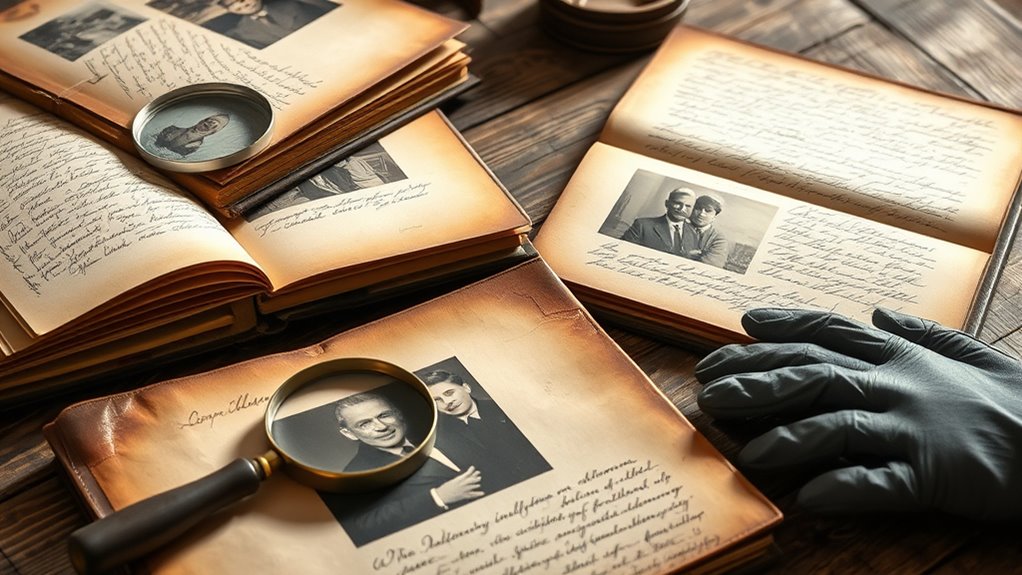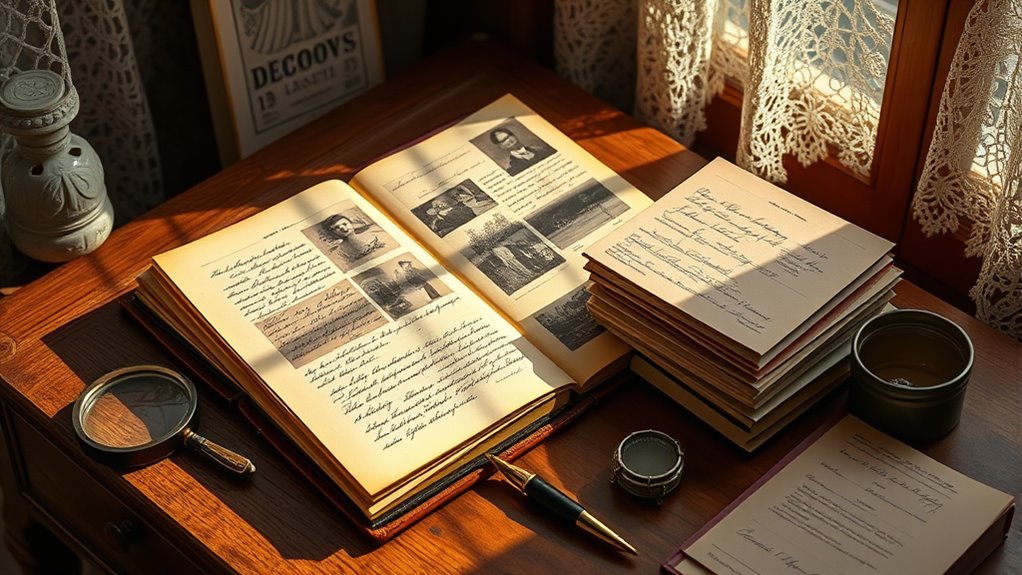To preserve family records, start by handling physical items carefully—store them in acid-free containers and keep them in cool, dark, dry places. Digitize photos and documents with high-quality scans, then back up these files on cloud services and external drives. Organize your digital files with clear labels and metadata, making them easy to find later. Remember, ongoing preservation involves regularly updating formats and storage methods—continue exploring the best strategies to safeguard your family’s history.
Key Takeaways
- Store physical documents in acid-free folders and boxes in a cool, dry, dark environment to prevent deterioration.
- Digitize physical records with high-resolution scans and organize files with clear labels and metadata.
- Use cloud storage and multiple backups to protect digital files from physical damage and data loss.
- Regularly review and update preservation methods, including software and storage formats, to ensure ongoing accessibility.
- Handle family records carefully, avoiding exposure to moisture, heat, or sunlight, and consider professional restoration for damaged items.

Have you ever wondered how to guarantee your family’s history stays alive for generations? The key lies in effective preservation techniques combined with modern digital archiving methods. Digital archiving is transforming the way we safeguard important family records, making it easier to store, access, and share precious memories without fear of deterioration. Traditional paper documents and photographs are fragile; they can fade, tear, or become damaged over time. By embracing digital archiving, you create a durable, accessible backup for these valuable items. Start by scanning photographs, letters, and documents at high resolution using a quality scanner. This process converts physical items into digital files, which can be stored securely on your computer or cloud services. Cloud storage provides the advantage of remote access and automatic backups, reducing the risk of losing everything to fire, flood, or hardware failure.
Digital archiving protects family history with high-resolution scans and secure cloud backups for lasting preservation.
When it comes to preservation techniques, handling your family records with care is vital. Keep physical items in acid-free folders and boxes to slow deterioration. Store them in a cool, dry, dark environment, away from direct sunlight and fluctuating temperatures. Avoid exposing photographs and documents to moisture or extreme heat, which accelerates decay. For digital files, use widely accepted formats like JPEG for images and PDF for documents to guarantee long-term accessibility. Regularly update and back up your digital archive to prevent data loss. Consider creating multiple copies stored in different locations—such as an external hard drive and cloud storage—to increase security. Additionally, understanding the importance of color accuracy in digital preservation can help maintain the visual integrity of scanned images over time.
Label your digital files meticulously with dates and descriptions, so you can easily identify and organize your records. This not only preserves the integrity of your collection but also makes future searches more manageable. If you’re tech-savvy, explore photo editing or restoration software to repair damaged images before archiving them digitally. Remember, preservation isn’t a one-time task; it’s ongoing. Periodically review your digital and physical collections, updating formats and storage methods as technology evolves. By doing so, you guarantee your family history remains intact and accessible for generations to come.
Ultimately, blending traditional preservation techniques with digital archiving gives you the best chance to protect your family’s legacy. It’s a proactive approach that combines careful handling with modern technology, allowing you to safeguard your history against the inevitable march of time. With a little effort now, you can guarantee that your family’s stories, photographs, and documents continue to inspire and connect future generations long after you’re gone.
Frequently Asked Questions
How Can I Digitize Fragile Family Documents Safely?
To digitize fragile family documents safely, start with digital scanning using a high-quality scanner to prevent further damage. Handle documents with clean, dry hands or wear gloves to avoid oils and dirt. Follow preservation best practices by supporting delicate pages with a flat surface and avoiding excessive pressure. Store the digital copies securely and back them up regularly, ensuring your treasured family history remains preserved and accessible for future generations.
What Are the Best Storage Materials for Old Photographs?
You’ll want to choose archival quality storage materials for old photographs, ensuring ideal photo preservation. Acid-free photo albums, sleeves, and boxes prevent deterioration and maintain color. Look for materials labeled as acid-free, lignin-free, and pH-neutral, because these qualities help your photos stand the test of time. Coincidentally, using the right storage materials safeguards your family’s memories, making sure they stay vibrant and intact for generations to come.
How Often Should I Review and Update My Family Records?
You should review and update your family records at least once every 1-2 years to verify your family history stays accurate and complete. Regular record maintenance helps you catch any missing details or errors and keeps your records organized. As your family grows or new information emerges, updating more frequently is beneficial. Staying consistent in reviewing your records guarantees they remain a valuable resource for future generations.
Are There Professional Services for Restoring Damaged Family Heirlooms?
Restoration specialists are your best bet for bringing damaged heirlooms back to life, almost like magic! They excel in heirloom conservation, carefully repairing and preserving your treasured items. Don’t attempt DIY fixes that could worsen the damage; instead, trust these experts who use specialized techniques to restore your family heirlooms with care and precision. This way, your cherished keepsakes stay beautiful and meaningful for generations to come.
How Do I Organize Family Records for Easy Access and Sharing?
You should start by creating a detailed record cataloging system, categorizing documents, photos, and family tree information for easy access. Use digital tools or folders to organize files logically—by family branch, date, or type. Label everything clearly, and consider sharing access via cloud storage for family members. Regularly update your records to keep the information current, making it simple for everyone to find and contribute to the family history.
Conclusion
Preserving your family records isn’t just about safeguarding paper and digital files; it’s about honoring memories that shape your identity. While technology offers quick access, it also risks loss or obsolescence. Balancing careful preservation with mindful sharing ensures your history endures. In a world racing forward, your family’s story remains a timeless anchor—fragile yet resilient—reminding you that history’s true value lies in connection, not just preservation. Embrace both, and your legacy will truly stand the test of time.








